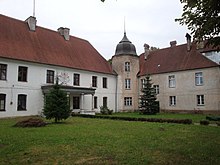Charbrowo
| Charbrowo | ||
|---|---|---|

|
|
|
| Basic data | ||
| State : | Poland | |
| Voivodeship : | Pomerania | |
| Powiat : | Lębork, | |
| Gmina : | Wicko | |
| Geographic location : | 54 ° 41 ′ N , 17 ° 36 ′ E | |
| Residents : | 746 (March 31, 2011) | |
| Postal code : | 84-352 (Wicko) | |
| Telephone code : | (+48) 59 | |
| License plate : | GLE | |
| Economy and Transport | ||
| Street : | Ext. 214 : Wicko - Łeba | |
| Next international airport : | Danzig | |
Charbrowo ( German Charbrow ) is a village in the municipality of Wicko ( Vietzig ) near Lębork ( Lauenburg i. Pom. ) In the Polish Pomeranian Voivodeship .
Geographical location
Charbrowo is located in Western Pomerania , about eight kilometers south of Łeba ( Leba ) and 18 kilometers northwest of Lębork ( Lauenburg ) on Voivodeship Road 214 , the former post road between Lauenburg and Leba. Neighboring villages are Krakulice ( Karlshof ) in the northwest, Wrzeście ( Freist ) in the east and Wicko ( Vietzig ) in the south, about 2 kilometers away .
history

Charbrowo, called Serberow in old documents , is an old church village with an outbuilding that used to be an aristocratic seat. In 1286, Duke Mestwin II of Pomerania gave Charbrow to the Kujavian cathedral chapter in Leslau . In 1564 the Lauenburg governor Ernst von Weiher , the older brother of the Camminer bishop Martin von Weiher , bought the villages Charbrow, Labenz and Ossecken , which had previously belonged to the Zuckau monastery , from the Leslau bishop Jakub Uchański for 12,000 thalers . In the 17th century, Charbrow fell to the Krockow family . Around the middle of the 18th century, the estate was bought by the Somnitz family , who managed it until the end of the Second World War in the spring of 1945. Around 1780 there was in Charbrow: a farm with a representative manor house, a water mill , a church with a preacher and a sexton , eleven farmers, five half-farmers , five kossaten , an inn, a forge and a total of 43 fireplaces (households). In addition to farming, the villagers also went fishing on Lake Leba and in three ponds. A market was held in the village twice a year. In the centuries before the land reform in Western Pomerania at the beginning of the 19th century, the village was owned by the Somnitz family.
During the Nazi era , Charbrow was renamed Degendorf in 1938 .
Towards the end of the Second World War Degendorf was occupied by the Red Army in the spring of 1945 and then placed under Polish administration. Based on its traditional name Charbrow, Degendorf was renamed Charbrowo . Until about 1947, the German population was from the village sold .
Parish

Since the Reformation in 1671 Lutheran pastor had looked after the parish until the year. Subsequently, Protestant Reformed clergy were active in the community until 1736, and then Lutheran clergy again until 1945. The church has been under the patronage of the von Somnitz-Charbrow family since the middle of the 18th century. As in Osseken and some other places in the Kashubian angle, in the 19th century the village church still preached in Kashubian in addition to German . Well-known pastors were:
- Paul Caßius (born October 5, 1667, † January 25, 1727) was pastor in Charbrow from July 1690 to mid-October 1701.
- Johann Behnke (* 1739), was pastor in Charbrow around 1780.
- August Bechthold was a pastor in Charbrow around 1870
- Kurt Trowitzsch, last German pastor before 1945
Personalities
- Lorenz Christoph von Somnitz (1612–1678), Kurbrandenburg statesman, donated the village church.
Population development
- 2008: 560
literature
- Franz Schultz : History of the Lauenburg district in Pomerania. 1912, pp. 339-343.
Web links
- References to the local history of Charbrow before 1945
- Pictures of Charbrow and tourist information
- Fallen from Charbrow during the Wars of Liberation 1806-1813
Individual evidence
- ^ CIS 2011: Ludność w miejscowościach statystycznych według ekonomicznych grup wieku (Polish), March 31, 2011, accessed on June 26, 2017
- ^ August Karl Holsche : Geography and Statistics of West, South and New East Prussia. In addition to a brief description of the history of the Kingdom of Poland up to its division . Volume 2, Berlin 1804, p. 249 .
- ↑ Johann Jakob Sell : History of the Duchy of Pomerania from the earliest times to the death of the last duke, or to the Peace of Westphalia . Part 1, Berlin 1819, pp. 349-350, footnote b) .
- ↑ Reinhold Cramer: History of the Lande Lauenburg and Bütow . Part I, Königsberg 1858, p. 183 .
- ↑ Czesław Biernat (Ed.): State Archives Danzig: Guide through the holdings up to 1945 . Oldenbourg, Munich 2000, p. 515 .
- ↑ Ludwig Wilhelm Brüggemann (Ed.): Detailed description of the current state of the Royal Prussian Duchy of Western and Western Pomerania : Part II, Volume 2, Stettin 1784, pp. 1066-1067, No. 12 .
- ^ Georg von Viebahn (Ed.): Statistics of the customs united and northern Germany . Part II: Population, mining, soil culture . Berlin 1862, p. 78.
- ^ Johann Christoph Strodtmann and Ferdinand Stosch (eds.): The new learned Europe . 17th part, Wolfenbüttel 1763, pp. 919-920 .
- ^ Georg Christoph Hamberger and Johann Georg Meusel (eds.): The learned Teutschland. Lexicon of the Germans now living . Volume 1, Lemgo 1796, p. 215.
- ^ August Bechthold: Chronicle of the Church in Charbrow, Lauenburg district in Pomerania . 1869.
- ↑ Kurt Trowitzsch: Chronicle of the church community Charbrow . 1951.


